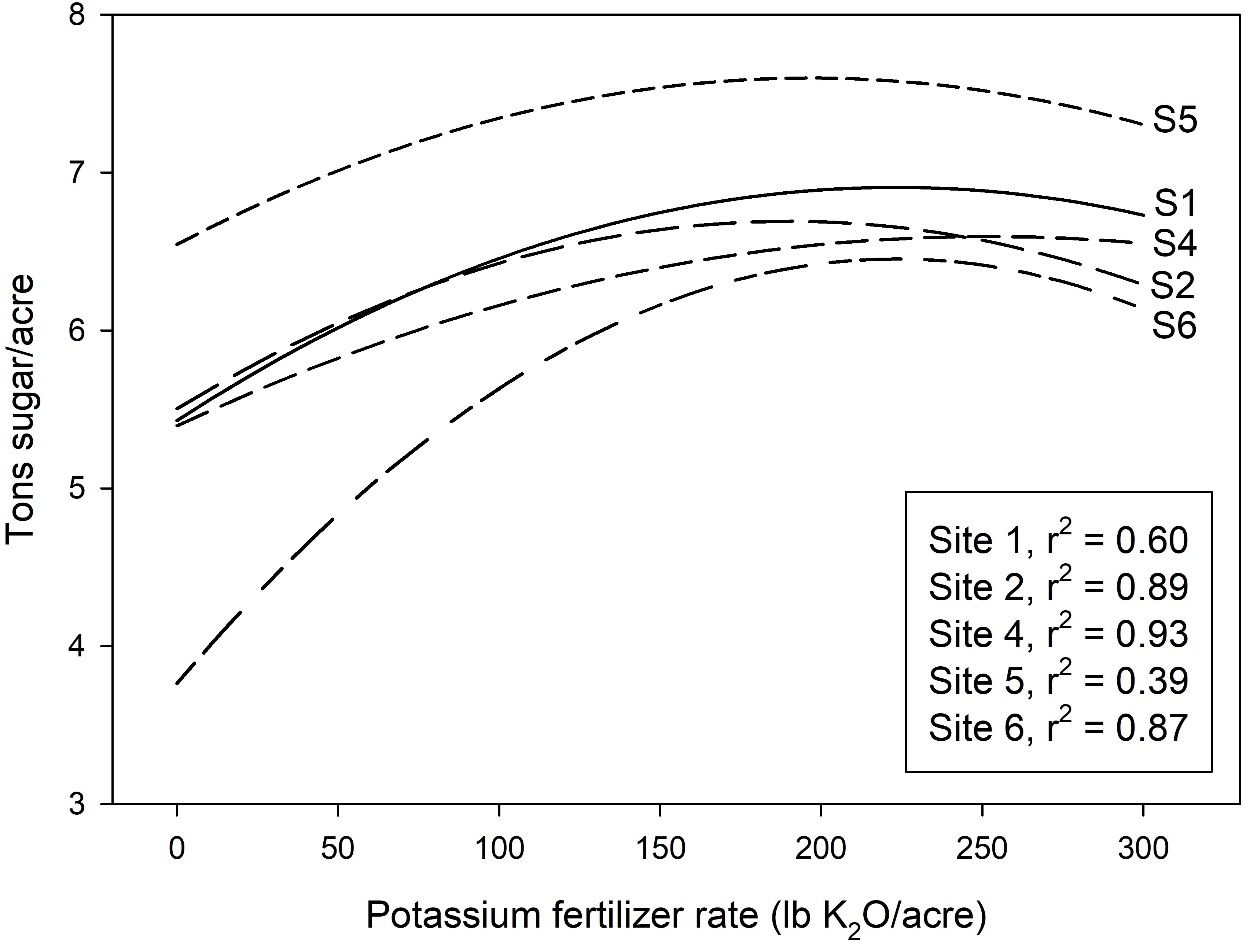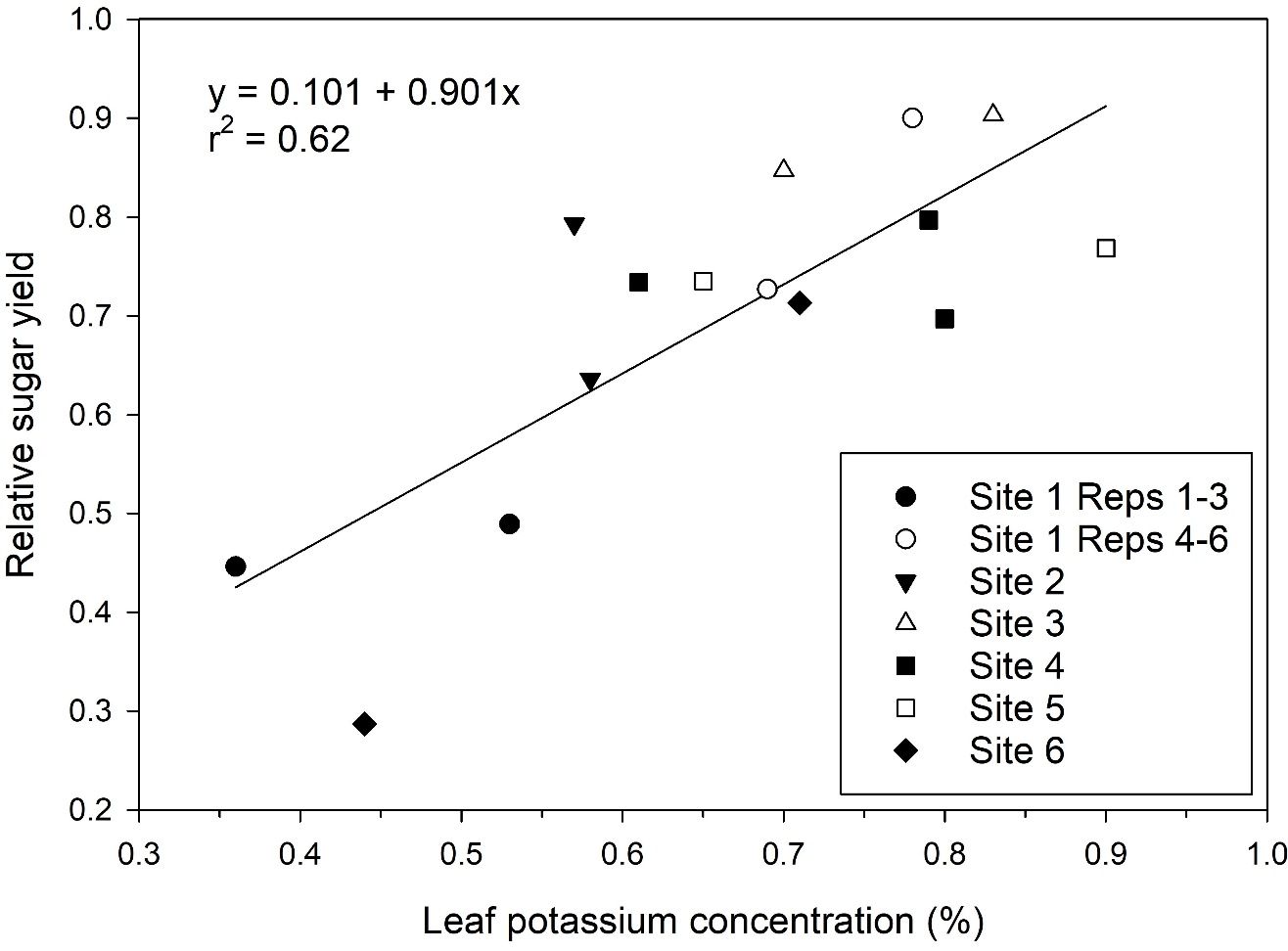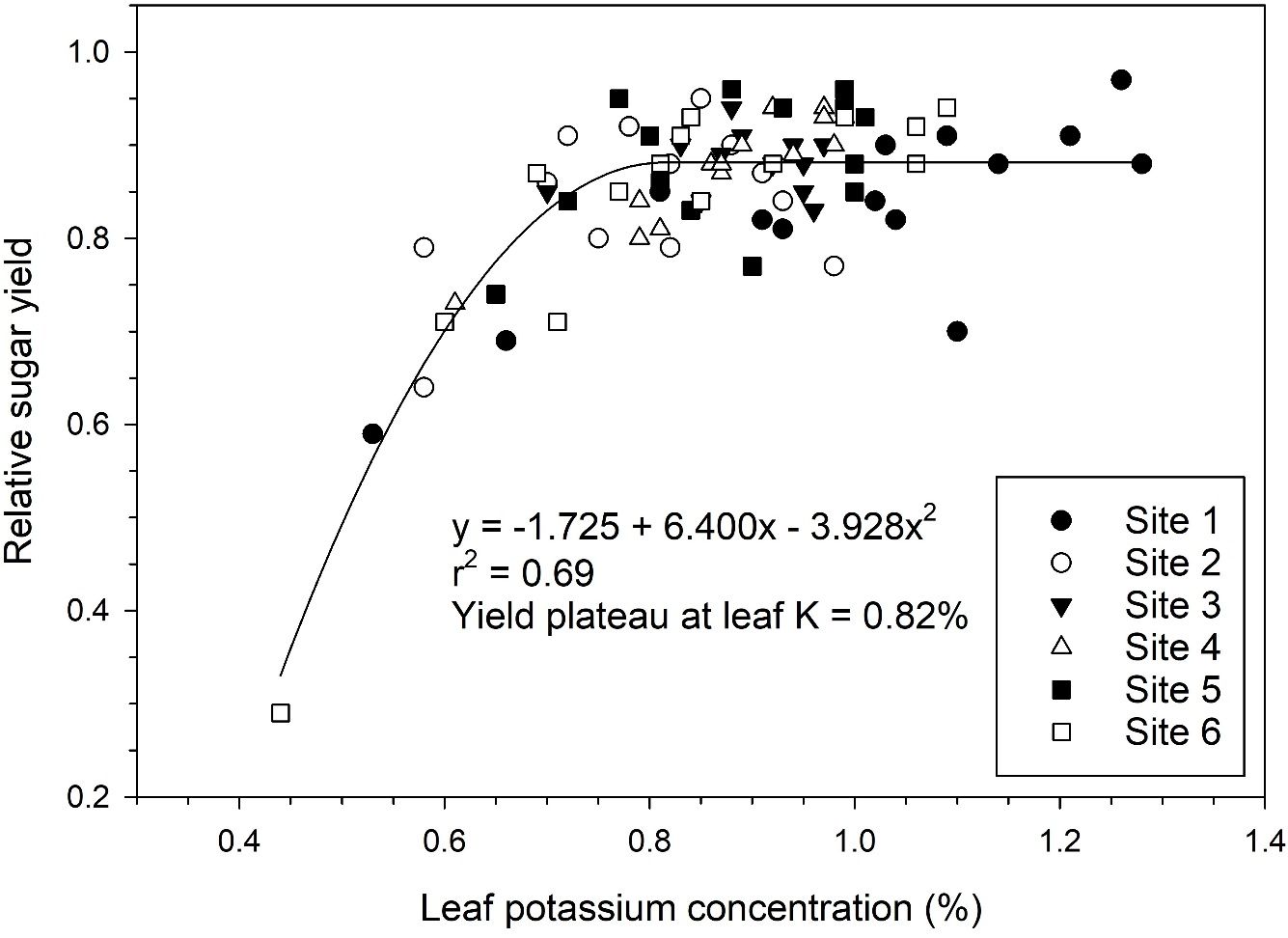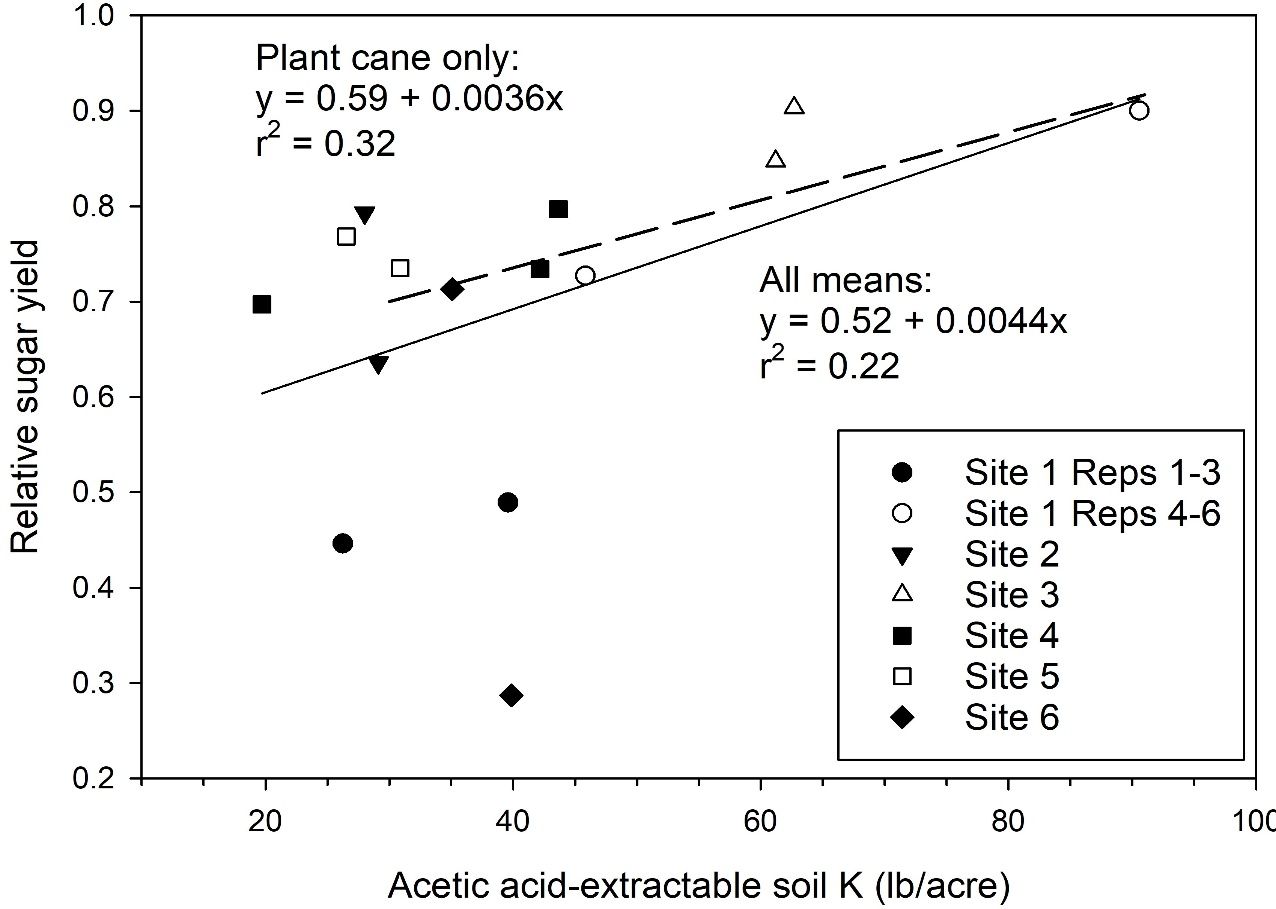Introduction
This publication is intended primarily for Florida sugarcane (Saccharum spp.) growers, but it may also be useful to researchers and others interested in sugarcane nutrition. It presents potassium (K) fertilizer recommendations for Florida mineral soils and supporting information.
Potassium is a primary plant nutrient that is required in large amounts by sugarcane. Potassium removed at harvest by sugarcane on mineral soils in Louisiana and Australia has ranged from 3.5 to 3.6 lb K/ton cane (Coale et al. 1993; Wood and Schroeder 2004), which corresponds to approximately 4.2 lb K2O/ton cane and 210 lb K2O/acre for a 50 tons cane/acre crop. Adequate K is important for regulation of water uptake, chlorophyll development, sugar translocation, drought and disease resistance, and reduced lodging (Gopalasundaram et al. 2012). Approximately 29% of the Florida sugarcane crop is grown on mineral soils (VanWeelden et al. 2021). These mineral soils are sands with low organic matter content and low nutrient-holding capacity, so K leaching occurs easily due to the high rainfall in the subtropical climate of south Florida. Because of the leaching potential, as with nitrogen (N) applications for sugarcane on mineral soils (McCray et al. 2019), K applications should be split to avoid nutrient loss and to maintain available soil K for the crop throughout the growing season (McCray et al. 2021).
Previous K fertilizer recommendations for sugarcane on mineral soils date back to the mid-1970s; however, there have been many changes in sugarcane cultivation in Florida, including expansion of sugarcane acreage on mineral soils, development of new sugarcane varieties, and improved use of amendments such as calcium silicate (McCray and Ji 2018). Therefore, there was a need to develop a new soil test calibration for sugarcane on sand soils in Florida. A study examining sugarcane yield response to K fertilizer was conducted at six locations (Table 1) (McCray et al. 2021), and the new sugarcane K fertilizer recommendations were developed.
Table 1. Sugarcane varieties, number of sugarcane crops, soil pH, soil organic matter (OM) content, soil density, and acetic acid-extractable K for each site of the potassium rate study.1
Sugarcane Yield Response to Potassium Fertilizer
Potassium fertilizer rates ranging from 0 lb K2O/acre to 300 lb K2O/acre were applied in six locations on mineral soils in and adjacent to the Everglades Agricultural Area in south Florida (Table 2) (McCray et al. 2021). Initial soil test K values ranged from 29 lb/acre to 91 lb/acre (Table 1) in these experiments conducted from 2012 through 2019. These soil test values were determined by extraction with 0.5 M acetic acid and are expressed as lb/acre in this publication and in recommendations provided to growers. The initial soil test values are also expressed as g K/m3; these values can be converted to lb/acre by multiplying by 1.36.
Table 2. Tons sugar/acre means for each K rate at each site in the K rate study.
Increased stalk weight and stalk population with K fertilizer application each contributed to yield increases in tons cane/acre and tons sugar/acre. Potassium fertilizer rate did not influence sucrose concentration. The tons sugar/acre yield parameter was the focus of the study because sucrose is the final product and is of primary interest for growers and sugar mills. Table 2 presents tons sugar/acre values for all sites. Site 3 was the only location where K rate did not significantly influence tons sugar/acre. Because there was a significant interaction between crop year and K rate at Site 6, tons sugar/acre values are presented for each crop year at that location (Table 2). Relationships, including quadratic models (Figure 1), between tons sugar/acre and K fertilizer rate were used to determine K fertilizer requirements.

Credit: McCray et al. (2021)
Figures 2, 3, and 4 use relative sugar yield as the measure of sugarcane yield. Relative sugar yield was determined by dividing tons sugar/acre for each plot by tons sugar/acre of the highest-yielding plot in that replication for each crop year at each site. The maximum relative yield in these graphs is 1.0. When evaluating zero K treatments as in Figures 2 and 4, relative yield between 0.9 and 1.0 indicate that there was little response to K fertilizer, while lower relative yield for zero K treatments is associated with stronger responses to K fertilizer. Relative yield is used because it allows comparison of yield response across different years and locations.

Credit: McCray et al. (2021)

Credit: McCray et al. (2021)

Credit: McCray et al. (2021)
Although there was not a significant sugarcane yield response to K fertilizer at Site 3, leaf K concentration was below the critical value of 0.9% at that location (McCray and Mylavarapu 2020) each crop year (Figure 2). Leaf K concentration in the zero K treatment was also below the critical value for replications 4–6 of Site 1 each crop year. Replications 1–3 and 4–6 of that location are shown separately because of the difference in soil organic matter content between those areas (Table 1). Comparing the linear relationship of leaf K concentration and relative sucrose yield in Figure 2 (zero K treatment only) with the quadratic plateau model in Figure 3 (all K treatments) demonstrates that there was insufficient K for optimum crop growth without added K fertilizer at all locations in the study. The six locations in this study were representative of the soils and conditions of sugarcane production on mineral soils in south Florida. This indicates that K fertilizer application will be required on all mineral soils for sugarcane in this region. The mineral soils in sugarcane production in Florida are sands with low capacity to retain nutrients, including K. With very little clay content and soil organic matter content typically < 2.5%, K leaching regularly occurs; therefore, split applications of K fertilizer will be required each year to maintain adequate K for the sugarcane crop.
Soil Test Potassium and Fertilizer Recommendations
There were significant linear relationships between acetic acid-extractable soil K and relative sugar yield (Figure 4). High variability in these relationships can be attributed to inherent field variability in these mineral soils, the influence of other limiting growth factors, and soil K. The relationship between soil K and relative sugar yield improved when results for only the plant cane crop were included so that the variable of crop year was removed (Figure 4). The linear relationship between soil K and relative sugar yield was similar to the relationship between leaf K concentration and relative sugar yield in Figure 2, in that a yield plateau was not reached in either relationship that evaluated only treatments with no K fertilizer. As described above, this indicates that Florida mineral soils will need a minimum K fertilizer rate each crop year.
The base K fertilizer rate is needed to ensure that adequate K is available for crop growth on these soils. At Site 3 where there was no significant yield response to K fertilizer, the 150 lb K2O/acre rate was required to achieve a leaf K concentration of at least 0.9% (critical value). With the difficulty of maintaining adequate leaf K concentration on these soils, a minimum base application of 150 lb K2O/acre is needed. Regression models were used to determine that the highest K fertilizer requirement for these soils was 250 lb K2O/acre (McCray et al. 2021). This gives a range of K fertilizer rates from 150 to 250 lb K2O/acre for sugarcane on mineral soils.
To determine soil test K ranges for recommended K fertilizer rates, the relationships between acetic acid-extractable soil K and relative sugar yield (Figure 4) were evaluated to determine logical break points for a calibration. For acetic acid-extractable soil K values of 40 lb/acre and less, there were relative yield values less than 0.7. In this range of potentially major yield reductions without K fertilizer, a rate of 250 lb K2O/acre is suggested. At Site 3, there was an initial acetic acid-extractable soil K value of 63 lb/acre. A minimum rate of 150 lb K2O/acre was required to achieve 0.9% leaf K at this location. Because of the difficulty of maintaining leaf K in the optimum range (1.0%–1.6%) (McCray and Mylavarapu 2020), a rate of 200 lb K2O/acre is suggested for this soil test level.
Because most fertilizer for sugarcane in Florida is banded in the furrow at planting or applied as a sidedress on the side of the row in later applications, fertilizer recommendations are made for all plant and ratoon crops based on preplant samples collected in disked fields so that spatial variability from banding has been removed (McCray 2019). Another consideration for developing a soil test calibration is field variability. Since this study was conducted in small plots (30 ft x 43.5 ft or 30 ft x 30 ft), and there is inherent spatial variability in these soils (Muchovej et al. 2000), allowances for variability should be made in determining soil test K values for specific K fertilizer rates. To account for this, the break points previously described were increased by approximately 20%.
Table 3 shows recommended K fertilizer rates for sugarcane on mineral soils in Florida. Rates range from 150 to 250 lb K2O/acre and are based on initial acetic acid-extractable soil K values before planting. The 150 lb K2O/acre rate in the new recommendations is intended for situations with relatively higher soil test K and possibly slightly higher soil organic matter content. While adequate K nutrition is important, excessive K rates should be avoided due to antagonism to magnesium (Mg) plant uptake. Additionally, Mg deficiency is often a chronic problem on our sand soils. Potassium fertilizer for sugarcane on mineral soils should be split at least twice each year. In an all-soluble fertilizer program (compared to a program including controlled-release fertilizer), at least three split applications are recommended each year to avoid excessive leaching of K fertilizer (McCray et al. 2021).
Table 3. Recommended K fertilizer for sugarcane grown on mineral soils based on acetic acid-extractable soil K.1
References
Coale, F. J., C. A. Sanchez, F. T. Izuno, and A. B. Bottcher. 1993. “Nutrient Accumulation and Removal by Sugarcane Grown on Everglades Histosols.” Agronomy Journal 85:310–315. doi:10.2134/agronj1993.00021962008500020028x.
Gopalasundaram, P., A. Bhaskaran, and P. Rakkiyappan. 2012. “Integrated Nutrient Management in Sugarcane.” Sugar Tech 14(1): 3–20. doi:10.1007/s12355-011-0097-x.
McCray, J. M. 2019. “Potassium Fertilizer Recommendations for Sugarcane on Florida Organic Soils.” SS-AGR-428. Gainesville: University of Florida Institute of Food and Agricultural Sciences. https://edis.ifas.ufl.edu/publication/AG428
McCray, J. M., and S. Ji. 2018. “Sugarcane Yield Response to Calcium Silicate on Florida Mineral Soils.” Journal of Plant Nutrition 41:2413–2424. doi:10.1080/01904167.2018.1510520.
McCray, J. M., S. Ji, and J. S. Alvarado. 2021. “Sugarcane Yield Response to Potassium Fertilization as Related to Extractable Soil Potassium on Florida Mineral Soils.” Agronomy Journal 113:5556–5568. doi:10.1002/agj2.20935.
McCray, J. M., K. T. Morgan, and L. Baucum. 2019. “Nitrogen Fertilizer Recommendations for Sugarcane Production for Sugar on Florida Sand Soils.” SS-AGR-401. Gainesville: University of Florida Institute of Food and Agricultural Sciences. https://edis.ifas.ufl.edu/publication/SC101
McCray, J. M., and R. Mylavarapu. 2020. “Sugarcane Nutrient Management Using Leaf Analysis.” SS-AGR-335. Gainesville: University of Florida Institute of Food and Agricultural Sciences. https://edis.ifas.ufl.edu/publication/AG345
Muchovej, R. M., Y. Luo, J. M. Shine Jr., and J. C. Jones. 2000. “Nutritional Problems Associated with Low Yield of Sugarcane on Mineral Soils.” Proceedings of the Soil and Crop Science Society of Florida 59:146–150.
VanWeelden, M., S. Swanson, W. Davidson, M. Baltazar, and R. Rice. 2021. “Sugarcane Variety Census: Florida 2020.” Sugar Journal 84(2): 6–15.
Wood, A. W., and B. L. Schroeder. 2004. “Potassium: A Critical Role in Sugarcane Production, Particularly in Drought Conditions.” CD-ROM. Proceedings of the Australian Society of Sugar Cane Technologists 26.